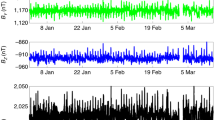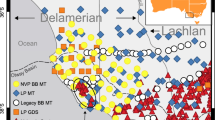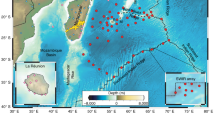Abstract
HOT regions in the upper mantle can be located in two ways. The first is the classical technique of mapping heat flow through the crust from measurements at numerous points. The more recent method of geomagnetic deep sounding (GDS) uses recording magnetometers at a number of stations to locate regions of enhanced electrical conductivity in the Earth through the magnetic fields of transient currents. Some, at least, of the ultra-basic silicates of the mantle are semiconductors which show a sharp rise of conductivity1 at temperatures above 1,000° C. While there is no one-to-one correspondence, it is probable that many of the known upper-mantle conductivity anomalies result from high temperatures. GDS is therefore an important means of seeking hot regions, hitherto limited by the small numbers of magnetometers available. Ocean floor spreading and plate tectonics have revolutionized earth science in the past few years. GDS affords means of extending study of the dynamic mantle demanded, especially under continents where little is yet known.
This is a preview of subscription content, access via your institution
Access options
Subscribe to this journal
Receive 51 print issues and online access
$199.00 per year
only $3.90 per issue
Buy this article
- Purchase on Springer Link
- Instant access to full article PDF
Prices may be subject to local taxes which are calculated during checkout
Similar content being viewed by others
References
Tozer, D. C., Phys. Chem. Earth, 3, 414 (1959).
Gough, D. I., and Reitzel, J. S., J. Geomag. Geoelect., 19, 203 (1967).
Schmucker, U., J. Geomag. Geoelect., 15, 193 (1964).
Gough, D. I., and Reitzel, J. S., in The Application of Modern Physics to the Earth and Planetary Interiors (edit. by Runcorn, S. K.), 139 (Wiley, New York, 1969).
Reitzel, J. S., Gough, D. I., Porath, H., and Anderson, C. W., Geophys. J. (in the press).
Porath, H., Oldenburg, D. W., and Gough, D. I., Geophys. J. (in the press).
Hamilton, R. M., J. Geophys. Res., 70, 5679 (1965).
Clark, S. P., and Ringwood, A. E., Rev. Geophys., 2, 35 (1964).
Carslaw, H. S., and Jaeger, J. C., Conduction of Heat in Solids, second ed. (Oxford, 1959).
Roy, R. F., Blackwell, D. D., and Birch, F., Earth Planet. Sci. Lett., 5, 1 (1968).
Gilluly, J., Amer. J. Sci., 265, 306 (1967).
Author information
Authors and Affiliations
Rights and permissions
About this article
Cite this article
GOUGH, D., PORATH, H. Long-lived Thermal Structure under the Southern Rocky Mountains. Nature 226, 837–839 (1970). https://doi.org/10.1038/226837a0
Received:
Revised:
Issue Date:
DOI: https://doi.org/10.1038/226837a0
Comments
By submitting a comment you agree to abide by our Terms and Community Guidelines. If you find something abusive or that does not comply with our terms or guidelines please flag it as inappropriate.



